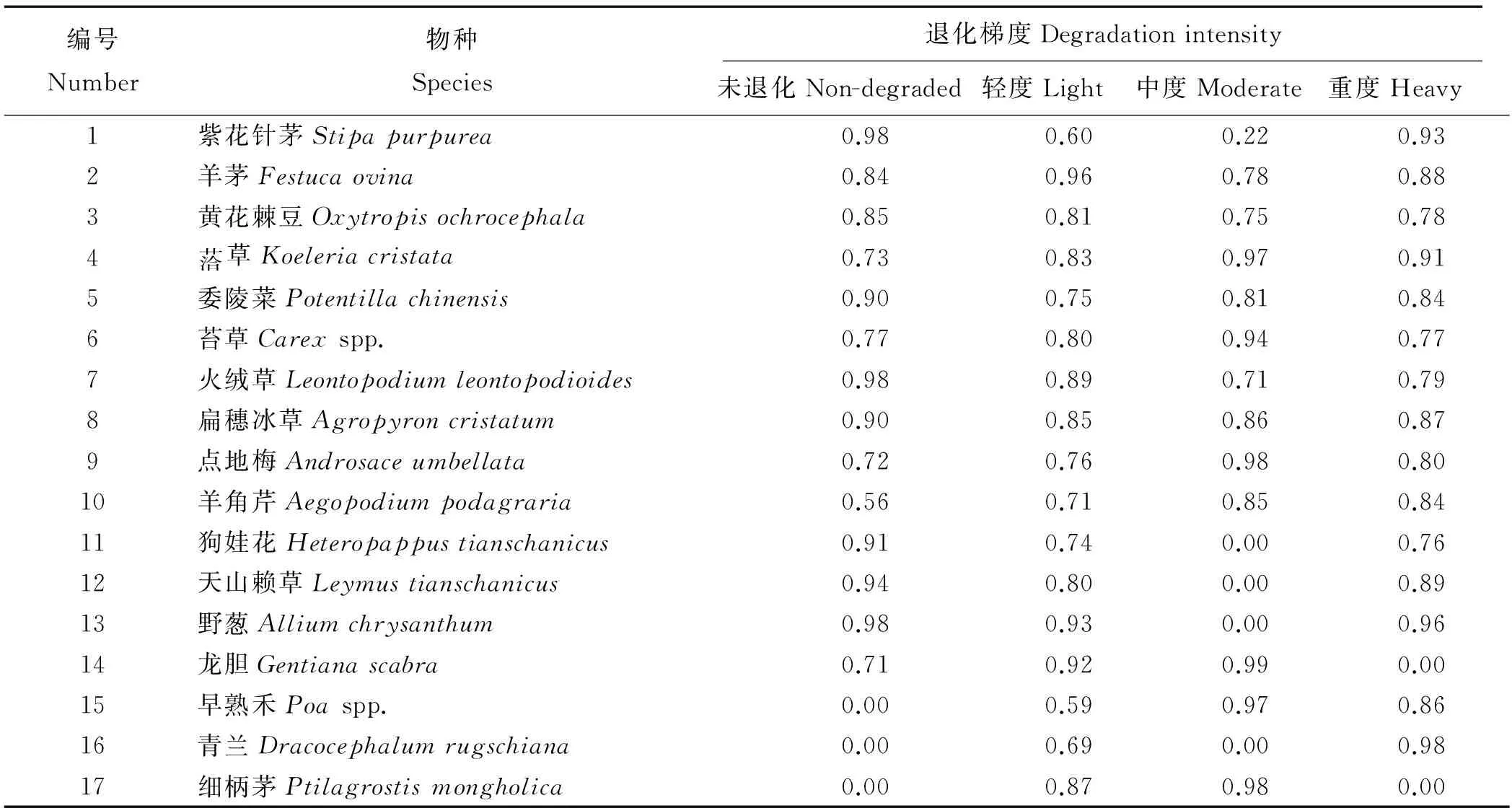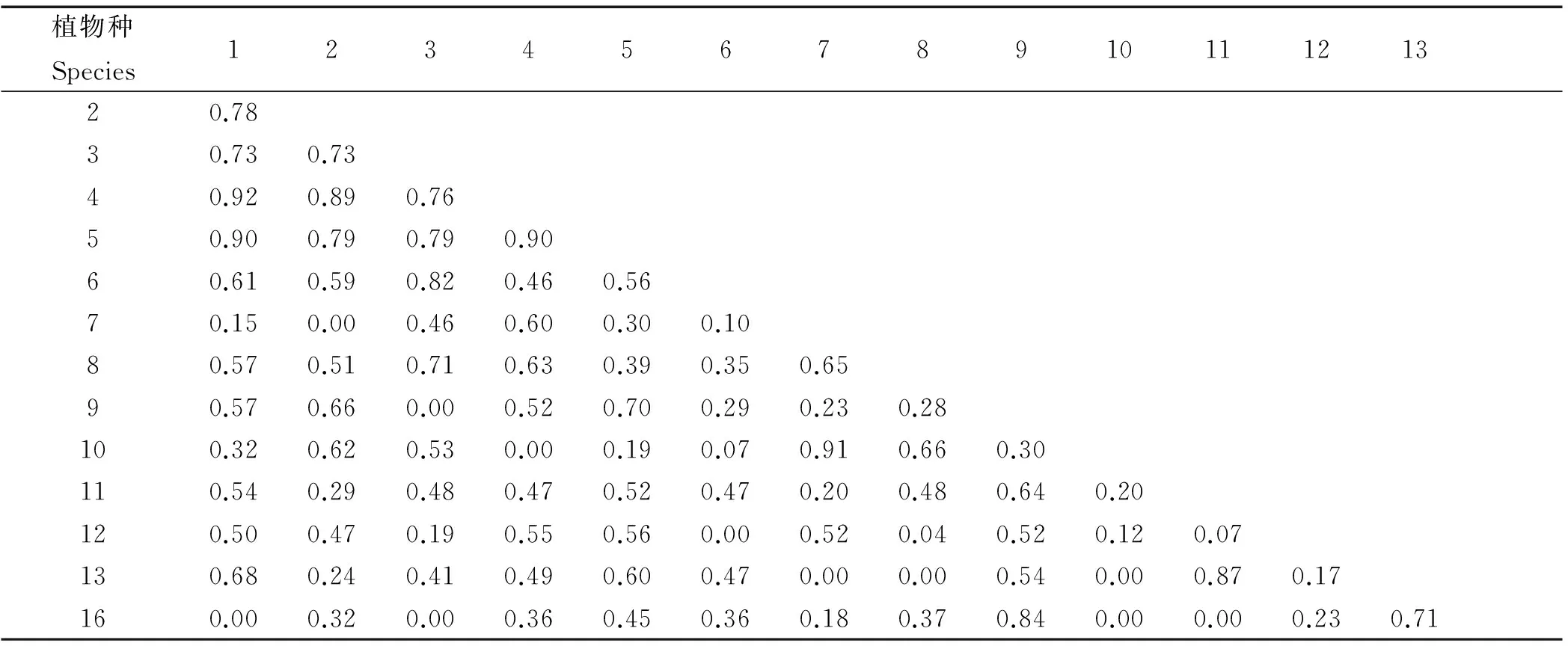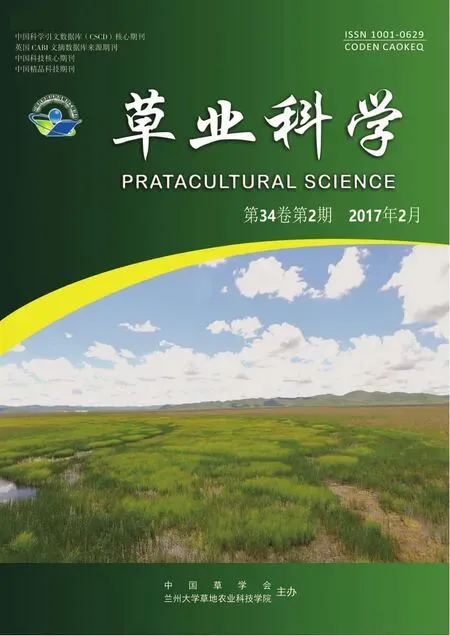不同退化梯度下大尤尔都斯高寒草原植物种群生态位特征
2017-03-23张爱宁安沙舟张蕊思夏小伟卡斯达尔努尔旦别克
张爱宁,安沙舟,张蕊思,夏小伟,卡斯达尔·努尔旦别克,董 磊
(1.新疆农业大学草业与环境科学学院,新疆草地资源与生态重点实验室,新疆 乌鲁木齐 830052;2.和静县草原工作站,和静 841300)
不同退化梯度下大尤尔都斯高寒草原植物种群生态位特征
张爱宁1,安沙舟1,张蕊思1,夏小伟1,卡斯达尔·努尔旦别克1,董 磊2
(1.新疆农业大学草业与环境科学学院,新疆草地资源与生态重点实验室,新疆 乌鲁木齐 830052;2.和静县草原工作站,和静 841300)
采用Levins生态位宽度指数(BLi)和Pianka生态位重叠指数(Qik),测定不同退化梯度下巴音布鲁克大尤尔都斯高寒草原17种主要植物的生态位宽度及生态位重叠。结果表明,未退化阶段,优势种紫花针茅(Stipapurpurea)的生态位宽度较高,轻度退化与中度退化阶段其生态位宽度减小,重度退化阶段又上升,其它物种根据群落结构变化生态位宽度发生变化。在不同退化梯度下均出现生态位较窄的种群生态位重叠较大的现象,物种间生态位重叠的变化是由种间生态学特性差异与草地退化对种间关系影响共同造成的。研究显示,在巴音布鲁克大尤尔都斯高寒草原,过度放牧导致草地退化,物种生态位重叠总体相对较低。
高寒草原;退化梯度;生态位宽度;生态位重叠
自1917年Joseph Grinnell提出生态位(niche)的定义以来,国外许多生态学者又陆续提出多种定义,并对生态位理论进行系统深入的研究[1-3]。20世纪70年代之后,生态位理论逐渐成为植物生态学中的研究热点[4],生态学家对生态位的概念及测定方法、植物种群对环境资源的利用、物种生态位与种间竞争关系等方面进行了深入研究[5-7]。测定生态位的主要内容包括生态位宽度及生态位重叠[8],在解释植物群落结构形成与变化、物种多样性变化、种间竞争关系、退化演替等问题上有重要作用[9-10]。
新疆巴音布鲁克高寒草原是我国第一大亚高山高寒草原,紫花针茅(Stipapurpurea)草原是其最重要、最具代表性的植物群系,也是新疆主要的优质放牧草地之一[8],但过度放牧导致草地严重退化,紫花针茅数量减少,杂类草数目增多[11]。研究表明,较大的生态位差异有利于草原植被稳定共生[12],橡树(Quercuspalustris)森林植被的多样性变化对其生态位和空间模式有重要影响[13],不同土壤深度下物种竞争、共生与生态位宽度及重叠值变化较大[14],草地豆科植物的生态位变化与其功能特征有关[15],半干旱区封育草地植被生态位与生态位重叠无明显的正相关关系[16],黄土区长期封育草地优势物种生态位宽度与生态位重叠对不同干扰的响应[17],南四湖湿地主要维管束植物生态位变化与土壤水热分布有重要联系[18],甘南高寒退化草地生态位宽度较大的两个种群也同样具有较高的相似比例与较大的生态位重叠[19],而关于我国新疆巴音布鲁克大尤尔都斯高寒草原植被的生态位研究较少,且主要集中于植被生态位变化对土壤资源的响应[20-22],未曾讨论植被与草地退化梯度间的联系。因此,本研究分析巴音布鲁克大尤尔都斯高寒草原17种主要植物种群随退化程度加剧其生态位的变化规律,进一步探讨主要植物种群在不同退化梯度下的生态关系及适应性,以期为该地区植被的群落结构变化及物种演替等方面提供依据。
1 材料与方法
1.1 研究地区概况

1.2 研究方法

1.3 数据分析
利用ENVI软件对每个样方的照片进行监督分类,计算得出植被盖度,结合高度、密度、生物量计算物种重要值(IV),采用Excel 2007计算植物生态位宽度及种间生态位重叠值。
IV=(Rh+Rc+Rd+Ry)/4.
式中:Rh是相对高度,Rc是相对盖度,Rd是相对密度,Ry是相对生物量[28]。

表1 大尤尔都斯高寒草原草地17种植物名录表
生态位宽度的计算运用Levins[28]提出后经Colwel[29]加权修改的公式:
BLi=1/(r∑Pij2),j=1,…,r
式中:BLi为物种i的生态位宽度;Pij指物种i在第j样方中的重要值占样方重要值之和的百分比,Pij=nij/Nij,Ni=∑nij,nij为物种i在第j样方中的重要值;r指样方数。
生态位重叠值的计算运用Pianka生态位重叠值公式[30]:
Qik=∑nijnkj/(∑nij2∑nkj2)1/2,j=1,…,r
式中:Qik指物种i和物种k的生态位重叠值,nij和nkj是种i和种k在样方j的盖度值,r是样方数。
2 结果与分析
2.1 植物种群生态位宽度


表2 不同退化梯度间主要物种的生态位宽度
2.2 植物种群生态位重叠


在巴音布鲁克大尤尔都斯,植物种间的生态位重叠值总体较低,重叠系数的平均值介于0.3~0.6,未退化、轻度退化、重度退化的重叠系数平均值分别为0.37、0.38和0.39,相差不大,说明该地区物种受复杂多变的环境条件对资源的需求出现分化,生态位重叠将有利于不同物种共享环境资源。而中度退化的重叠系数平均值为0.54,说明在中度退化梯度下植被对环境资源的竞争非常激烈,群落结构在此阶段发生巨大变化。

表3 未退化阶段主要种群生态位重叠值
注:物种编号1~17同表示。表4、5、6同。
Note: The number of species (1~17) are same as those in Table 1, similarly for the following tables.

表4 轻度退化阶段主要种群生态位重叠值

表5 中度退化阶段主要种群生态位重叠值
3 讨论与结论
3.1 生态位宽度
生态位的宽度是反映植物种群对生境资源利用能力及利用状况的重要指标[31]。不同退化梯度下,植被生态位宽度既可反映种群对退化草地的资源利用状况,也可明确各种群的群落地位及结构[32]。
在巴音布鲁克大尤尔都斯区域,不同物种的生态位宽度因草地退化梯度的不同出现较大的差异,这种差异是不同退化梯度和物种不同的生态学特性共同作用的结果。然而,引起植物生态位变化的主要内部因素是植物自身的生态学特性,不同种植物对环境资源的需求不同,因此对生态空间的利用状况也有所不同[33],如紫花针茅在该地区具有特殊的适应机制,叶片纵卷成针状,能够有效阻止水分散失,同时紫花针茅具有基生叶稠密,根系发达的特点,能够密集成片生长,能够充分利用环境资源,因此,在重度退化阶段,大部分植被生态位宽度均下降,而紫花针茅凭借自身独特的适应机制重新成为该区的主要优势种。

表6 重度退化阶段主要种群生态位重叠
3.2 生态位重叠
生态位重叠是指两个或两个以上生态位相似的物种对同一生境资源的共同分享或竞争的现象[34]。生态位重叠反映了种群对同生境条件下资源的利用状况、竞争关系及种间对生态空间资源利用的相似程度[24-25],生态位较大的种群具有较高生态位重叠值[2,8,10,19],但半干旱区人工封育草地植被生态位与生态位重叠无明显的正相关关系,并且生态位较窄的种群与生态位较宽的种群间也会形成较高的生态位重叠值[16]。本研究表明,在未退化草地区域,植被的生境资源充足,植物生态位重叠表明物种间的生态学特性及其占据的生态空间相似。但随着草地退化程度加剧,环境资源供给不足时,植被的生态位重叠不仅表明种间的生态学特性相似,也表明种间存在竞争关系[35-36]。生态位宽度较大的物种间存在较大的生态位重叠,生态位宽度较窄的物种间存在较小的生态位重叠,这与多数的研究结果一致[26-27]。然而在不同退化梯度下,均出现生态位宽度较窄的种群间的生态位重叠值较大的现象,这可能是由于巴音布鲁克大尤尔都斯高寒草原特有的水热条件与放牧强度共同影响造成。首先,该区域为高山盆地,高寒草原植被生长所需资源仅限于盆地内部,导致物种在有限的环境空间内产生激烈的竞争关系。其次,放牧强度变化可能引起生境内水热变化,而物种需要适应水热变化,在长期的演变过程中,物种的生态位随之发生变化,如中度退化阶段,紫花针茅群落结构明显变化时期,低矮植被点地梅与青兰、羊角芹与龙胆为充分争夺有限的环境资源,种间竞争加剧,出现较高的生态位重叠现象。因此,放牧和水热变化都有可能引起物种生态位变化,但究其主导因素还需要进行后续研究。
References:
[1] 程中秋,张克斌,刘建,常进,王晓,王黎黎,苏鹏飞.宁夏盐池荒漠草原区天然草地植物生态位研究.水土保持研究,2011,18(3):36-40,47. Cheng Z Q,Zhang K B,Liu J,Chang J,Wang X,Wang L L,Su P F.The study on vegetable niche of natural grassland of desertification grassland region in Yanchi County,Ningxia.Reasearch of Soil and Water Conservation,2011,18(3):36-40,47.(in Chinese)
[2] 刘锦霞,武高林,马涛.毛乌素沙漠边缘荒漠植物群落生态位特征研究.草业科学,2007,24(12):9-14. Liu J X,Wu G L,Ma T.Study on niche characteristics of desert plant community in marginal zone of Muus Desert.Pratacultural Science,2007,24(12):9-14.(in Chinese)
[3] 潘高,张合平,潘登.南方红壤丘陵区3种森林群落内主要草本植物种群生态位特征.草业科学,2015,32(12):2094-2106. Pan G,Zhang H P,Pan D.Niche characteristics of herb populations within three forest types in hilly red soil region of southern China.Pratacultural Science,2015,32(12):2094-2106.(in Chinese)
[4] 于建梅,胡玉昆,李凯辉,范永刚,柳妍妍,高国刚.巴音布鲁克高寒草地主要植物种群生态特征分析.干旱区资源与环境,2007,21(7):155-159. Yu J M,Hu Y K,Li K H,Fan Y G,Liu Y Y,Gao G G.Analysis on ecological characteristics of main plants in alpine meadow of Bayanbulak.Journal of Arid Land Resources and Environment,2007,21(7):155-159.(in Chinese)
[5] Arbams P A.Alternative models of character displacement and niche shift 1.Adaptive shifts in resource use when there is competition for nutritionally non-substitutable resources.Evolution,1987,41(3):651-661.
[6] Silvertown J W,Mike E D.Hydrologically defined niches reveals a basis for species richness in plant communities.Nature,1999,400:61-63.
[7] Thomas M G,Robert K S.Niche breadth,ecologically scaled responses to habitat fragmentation:Mammalian predators in an agricultural landscape.Biological Conservation,2003,109:283-295.
[8] 王鑫,胡玉昆,热合木都拉·阿迪拉,李凯辉,于建梅,柳妍妍,张晓艳.巴音布鲁克高寒草原羊茅(Festucaovina)群落生态位特征.干旱区地理,2009,32(2):255-260. Wang X,Hu Y K,Rehemudula·Adila,Li K H,Yu J M,Liu Y Y,Zhang X Y.Niche characteristics ofStipapurpureacommunity in alpine meadow of Baynbulak.Arid Land Ggeography,2009,32(2):255-260.(in Chinese)
[9] 郑伟,董全民,李世雄,刘玉.放牧对环青海湖高寒草原主要植物种群生态位的影响.草业科学,2013,30(12):2040-2046. Zheng W,Dong Q M,Li S X,Liu Y.Effects of grazing on niche of major plant populations in alpine steppe in Qinghai Lake Region.Pratacultural Science,2013,30(12):2040-2046.(in Chinese)
[10] 李明,蒋德明,押田敏雄,周全来,骆永明.科尔沁沙地人工固沙群落草本植物种群生态位特征.草业科学,2009,26(8):10-16. Li M,Jiang D M,Oshida T,Zhou Q L,Luo Y M.Niche characteristic of herbages in artificial sand-fixing communities in Horqin sandy land.Pratacultural Science,2009,26(8):10-16.(in Chinese)
[11] 柳妍妍,胡玉昆,公延明.高寒草原不同退化阶段土壤颗粒分形特征.水土保持通报,2013,33(5):138-142,184. Liu Y Y,Hu Y K,Gong Y M.Fractal dimensions of soil particles in different degenerate stages of alpine steppe.Bulletin of Soil and Water Conservation,2013,33(5):138-142,184.(in Chinese)
[12] Chu C J,Peter B.Large niche differences emerge at the recruitment stage to stabilize grassland coexistence.Ecological Monographs,2015,85(3):373-392.
[13] Szymura T H,Szymura M,MacioA.The effect of ecological niche and spatial pattern on the diversity of oak forest vegetation.Plant Ecology & Diversity,2015,8(4):505-518.
[14] Carlos M,Citlali A,Almanza C,Eduardo A.Pérez-García,Jorge G,Sánchez-Ken.Co-existence in a species-rich grassland:Competition,facilitation and niche structure over a soil depth gradient.Journal of Vegetation Science,2015,26(4):674-685.
[15] Fort F,Jouany C,Cruz P.Hierarchical traits distances explain grassland Fabaceae species’ ecological niches distances.Frontiers in Plant Science,2015,6:1-11.
[16] 苗静,张克斌,刘建康,刘小丹.半干旱区人工封育草地植被生态位研究.水土保持研究,2015,22(4):342-347. Miao J,Zhang K B,Liu J K,Liu X D.Niche characteristics of plants in artificial fencing field of Yanchi County in semi-arid area.Reaearch of Soil and Water Conservation,2015,22(4):342 -347.(in Chinese)
[17] 井光花,程积民,苏纪帅,魏琳,史晓晓,金晶炜.黄土区长期封育草地优势物种生态位宽度与生态位重叠对不同干扰的响应特征.草业学报,2015,24(9):43-52. Jing G H,Cheng J M,Su J S,Wei L,Shi X X,Jin J Y.Response of dominant population niche breadths and niche overlaps to various disturbance factors in typical steppe fenced grassland of China’s loess plateau region.Acta Prataculturae Sinica,2015,24(9):43-52.(in Chinese)
[18] 梁玉,范小莉,王强,刘伯燕,房用,王卫东.南四湖湿地主要维管束植物生态位特征.山东林业科技,2016(2):17-21. Liang Y,Fan X L,Wang Q,Liu B Y,Fang Y,Wang W D.Niche character of main vascular plants in Nansi lake.Shandong Forestry Science and Technology,2016(2):17-21.(in Chinese)
[19] 陈文业,戚登臣,李广宇,魏强,王芳,孙飞达,刘振恒,朱丽.甘南高寒退化草地生态位特征及生产力研究.自然资源学报,2010,25(1):80-90. Chen W Y,Qi D C,Li G Y,Wei Q,Wang F,Sun F D,Liu Z H,Zhu L.Study on degraded grassland niche characteristics and productivity of alpine meadow at Maqu in south of Gansu province.Journal of Natural Resources,2010,25(1):80-90.(in Chinese)
[20] 范永刚,胡玉昆,李凯辉,于建梅,王鑫.不同干扰对高寒草原群落物种多样性和生物量的影响.干旱区研究,2008,25(4):531-536. Fan Y G,Hu Y K,Li K H,Yu J M,Wang X.Effects of different disturbances on the diversity and biomass of the phytobiocoenoses in alpine steppes.Arid Zone Research,2008,25(4):531-536.(in Chinese)
[21] 房飞,胡玉昆,张伟,公延明,柳妍妍,杨秀娟.高寒草原植物群落种间关系的数量分析.生态学报,2012,32(6):1898-1907. Fang F,Hu Y K,Zhang W,Gong Y M,Liu Y Y,Yang X J.Numerical anailsis of inter-specfic relationships in alpine steppe community in Bayanbulak.Ecologica Sinica,2012,32(6):1898-1907.(in Chinese)
[22] 尹伟,胡玉昆,柳妍妍,公延明,张伟,刘伟,阿德列提·艾列吾塔力甫.巴音布鲁克不同建植期人工草地土壤生物学特性研究.草业学报,2010,19(5):218-226. Yi W,Hu Y K,Liu Y Y,Gong Y M,Zhang W,Liu W,Adejieti·Abeutalipu.Astudy on soil biological properties of artificial grassland over different cultivation times in Bayanbulak.Acta Prataculturae Sinica,2010,19(5):218-226.(in Chinese)
[23] 何文革,李小芳,李文利.巴音布鲁克草原重要作用及其退化原因与利用建议.湖北畜牧兽医,2008(10):33-34. He W G,Li X F,Li W L.The Important role in the use of recommendation and grassland degradation reasons over Bayinbuluke.Hubei Journal of Animal and Veterinary Science,2008(10):33-34.(in Chinese)
[24] 杜军剑,张仕明,李刚.巴音布鲁克草原植被生长气象条件指数变化特征.沙漠与绿洲气象,2014,8(1):45-50. Du J J,Zhang S M,Li G.The meteorological conditions index variation characteristics of grassland vegetation growth over bayinbuluke.Desert and Oasis Meteorology,2014,8(1):45-50.(in Chinese)
[25] 梁娜,靳瑰丽,安沙舟,赛米拉克孜·台外库力,迪丽努尔·玉苏甫江.伊犁绢蒿退化荒漠草地植物种群生态位的变化特征.草业科学,2013,30(12):2059-2065. Liang N,Jin G L,An S Z,Saimilakezi·Taiwaikuli,Dilinuer·Yusupujiang.Plant population niche characteristics research of desertSeriphdiumtransiliensedegradation grassland.Pratacultural Science,2013,30(12):2059-2065.(in Chinese)
[26] 胡健波,张璐,黄伟,吴世红,刘长兵.基于数码照片的草地植被覆盖度快速提取方法.草业科学,2011,28(9):1661-1665. Hu J B,Zhang L,Huang W,Wu S H,Liu Z B.Quickly determining grassland cover using the digital image.Pratacultural science,2011,28(9):1661-1665.(in Chinese)
[27] 王仁忠,李建东.采用系统聚类分析法对羊草草地放牧演替阶段的划分.生态学报,1991,6(4):367-371. Wang R Z,Li J D.Cluster analysis method for dividing successinal stages ofAnurolepidiumchinensegrassland for grazing.Acta Ecologica Sinica,1991,6(4):367-371.(in Chinese)
[28] Levins R.Evolution in Changing Environments:Some Theoretical Explorations.Princeton:Princeton University Press,1968.
[29] Colwell R K,Futuyma D J.On the measurement of the niche breadth and overlap.Ecogogy,197l,52:567-576.
[30] Pianka E R.The structure of lizard community.Annual Review of Ecology& Systematics,1973,4:53-74.
[31] 程中秋,张克斌,常进,王黎黎,王晓,赵紫阳.四儿滩地区植物种群的生态位.草业科学,2012,29(04):615-623. Cheng Z Q,Zhang K B,Chang J,Wang L L,Wang X,Zhao Z Y.Plant population niche in Siertan wetland.Pratacultural Science,2012,29(4):615-623.(in Chinese)
[32] 孙鹏举,陈英.甘南草地生态系统生态位适宜度及其空间差异分析.草业科学,2009,26(4):1-5. Sun P J,Chen Y.Analysis of niche suitability and spatial difference of grassland ecosystem in Gannan.Pratacultural Science,2009,26(4):1-5.(in Chinese)
[33] 胡相明,程积民,万惠娥,赵艳云.黄土丘陵区不同立地条件下植物种群生态位研究.草业学报,2006,15(1):29-35. Hu X M,Cheng J M,Wan H E,Zhao Y Y.Studies on the niches of the main populations in different habitats of the Loess Hilly Region.China.Acta Prataculturae Sinica,2006,15(1):29-35.(in Chinese)
[34] 庞吉林,张克斌,王海星,王黎黎,王晓,苏朋飞.盐池县人工封育草地植物生态位动态研究.草业科学,2012,29(8):1285-1293. Pang J L,Zhang K B,Wang H X,Wang L L,Wang X,Su P F.Vegetable niche dynamic study of the enclosed desertification rangeland in Yanchi County.Pratacultural Science,2012,29(8):1285-1293.(in Chinese)
[35] 林丽,赵成章,龙瑞军,王帅,王溪,李以康,张法伟.石羊河上游退化草地植物功能群生态位分异特征——以阿尔泰狗哇花型草地为例.草业科学,2009,26(5):50-55. Lin L,Zhao C Z,Long R J,Wang S,Wang X,Li Y K,Zhang F W.Niche differentiation charecterisitics of plant functional groups on degraded grassland in the upstream of Shiyang River.Pratacultural Science,2009,26(5):50-55.(in Chinese)
[36] 梁娜,靳瑰丽,安沙舟,赛米拉克孜·台外库力,迪丽努尔·玉苏甫江.伊犁绢蒿退化荒漠草地植物种群生态位的变化特征.草业科学,2013,30(12):2059-2065. Lang N,Jin G L,An S Z,Saimilakezi·Taiwaikuli,Dilinuer·Yusupujiang.Plant population niche characteristics research of desertSeriphdiumtransiliensedegradation grassland.Pratacultural Science,2013,30(12):2059-2065.(in Chinese)
(责任编辑 武艳培)
Study on niche characteristics of the plant community in the alpine grassland of Big Youerdusi under a degeneration gradient
Zhang Ai-ning1, An Sha-zhou1, Zhang Rui-si1, Xia Xiao-wei1, Kasidaer·Nuerdanbieke1, Dong Lei2
(1.College of Pratacultural and Environmental Science, XinJiang Agricultural University,Key Laboratory of Grassland Resources and Ecology of XinJiang, Urumqi 830052, China;2.The Grassland Workstation in Hejing, Hejing 841300, China)
The Levins niche breadth index (BLi) and Pianka niche overlap index (Qik) were used to study the niche breadth and the niche overlap of 17 main kinds of plants within different degradation gradient in an alpine grassland of Big Youerdusi. Results showed that the niche breadth of dominant speciesStipapurpureawas higher than others in the non-degraded stage, it was decline in the light degradation and moderate degradation stages, and then it increased in the heavy degradation stages. The change of niche breadth of other species changed based on the community structure. There was a phenomenon that plant species with narrow niche breadth had high niche overlap in different degeneration stages; the reason for this change of niche overlap was the interactive effects of different species’ ecological characteristics and grassland degradation on interspecific relationships. In conclusion, overgrazing has led to grassland degradation, and the plant species niche overlap is relatively low, in the alpine grassland of Big Youerdusi.
alpine grassland; degradation intensity; niche breadth; niche overlap
An Sha-zhou E-mail:xjasz@126.com
10.11829/j.issn.1001-0629.2016-0289
2016-05-30接受日期:2016-08-30
国家自然科学基金“巴音布鲁克高寒湿地CO2和CH4排放对水分变化的响应(41305136)”
张爱宁(1989-),女,新疆和田人,在读博士生,主要从事草地资源与生态研究。E-mail:zhangaining1206@163.com
安沙舟(1956-),男,陕西富平人,教授,博士,主要从事草地资源与生态研究。E-mail:xjasz@126.com
S812.29;Q948.15
A
1001-0629(2017)2-0302-08
张爱宁,安沙舟,张蕊思,夏小伟,卡斯达尔·努尔旦别克,董磊.不同退化梯度下大尤尔都斯高寒草原植物种群生态位特征.草业科学,2017,34(2):302-309.
Zhang A N,An S Z,Zhang R S,Xia X W,Kasidaer·Nuerdanbieke,Dong L.Study on niche characteristics of the plant community in the alpine grassland of Big Youerdusi under a degeneration gradient.Pratacultural Science,2017,34(2):302-309.
